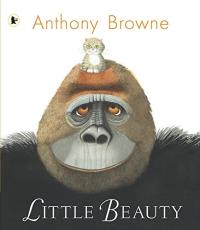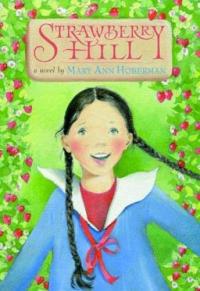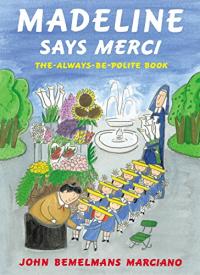
A baby kangaroo jumps out of its mother pouch, each time going a little farther, but each time returning after meeting an unexpected animal. Like children, however, Joey, finally recognizes itself in another and leaves his mother’s safety for a bit longer. Repetition and lively illustrations make this an engaging story.
Pouch!

The arctic environment contrasts with the warmth of a mother polar bear and her cub who emerge from their den for the first time. The mother’s encouragement allows her child to build confidence as he grows and explores his wintry but safe surroundings. This gentle, handsomely illustrated story makes a comforting bedtime book.
My Little Polar Bear

While parents may be miffed when young dinosaurs test limits, they are always reassured of their parents’ cunfailing love. Told in rhyme, this latest addition to the series by this talented writer/artist team is sure to please young children as they cuddle with their parents.
How Do Dinosaurs Say I Love You?

The round little dog has a colorful ball but no one to play with; all of the farm animals have excuses. Dog is forlorn until a pair of human hands picks up the ball — and fun can start. Simple language in an easy rhyme combines with colorful, gentle illustrations for a satisfying story.
Dog Wants to Play

A loud “plop!” sounds while a bunch of bunnies are eating. Off they run, frightening other animals into running away as well, including a big brave bear. Only the smallest and brightest young rabbit (who notices the apples dropping into water) enjoys a repast alone. Rhythmic language and retro illustrations make this cumulative tale fresh.
The Terrible Plop

A boy and his dog foil the ravenous intentions of a super hungry T-Rex that shows up unexpectedly in the backyard. After taming the creature, mom provides a huge plate of pasta to make a “super full dinosaur” who happily leaves, but only after after a very large, satisfying burp. Child-like illustrations add appeal in this very silly, engaging tale.
The Super Hungry Dinosaur

Otis, a small tractor, becomes despondent when he is replaced by a larger, more modern tractor. Even his friend, a once lonely calf, can’t stir Otis — that is, until the calf becomes stuck in a pond of mud and only small, brave Otis can save her. A limited palette and onomatopoeic language create an old-fashioned feeling and completely satisfying book.
Otis

Beauty is a small kitten who becomes a large gorilla’s best friend as they happily share their lives together (reminiscent of Koko’s Kitten). When “King Kong” is mistreated, the gorilla smashes the television. The keepers come to remove Beauty, but Beauty signs that she broke the TV, not her friend. Realism and fantasy combine in this smart, expressive book.
Little Beauty

In spite of a grumpy dad who literally turns into a grizzly bear — as seen in the very amusing illustrations — the grizzly dad and his son enjoy an outing together. By the time the mom and other child return home at the end of the day, dad has returned to himself. The literal transformation is not only child-like, but the notion will be broadly appreciated!
Grizzly Dad

Bespectacled Sunday Chutney has an unusual name — and she’s always the new girl as her family moves frequently for her dad’s work. Her voice is real as is her take on herself and her life (which she admits is sometimes lonely) and utterly charming. The illustrations are as quirky as the character herself.
Sunday Chutney

In a companion to A Chair for My Mother, young Rosa awaits the birth of her baby cousin in the now slightly frayed chair so lovingly purchased long ago. When the baby is born, Rosa introduces him to the much-loved chair and its history in this sincere and warmly told and illustrated family story.
A Chair for Always

A boy’s grandfather is always grumpy, fussy, and yelling. But when grandfather and grandson go fishing together, they wind up having a laugh and finding a way to communicate. Stylized illustrations are used effectively in this story of learning to appreciate relatives who may have forgotten what it’s like to be young.
Grumpy Grandpa

Ten year old Allie Sherman resists her family’s move until she learns that they will live on Strawberry Hill. It is on this intriguing sounding street that Allie finds a friend, confronts racism, and comes to appreciate her family. Set during the Great Depression, this nostalgic novel continues to ring true.
Strawberry Hill

Paulie Pastrami is just a kid, and a kid who even has trouble getting his socks to match. But Paulie has big plans. In order to achieve his plan of world peace, Paulie begins with small kindnesses which are sure to grow. Bold, comic illustrations complement this recognizable, winning, and empowering story.
Paulie Pastrami Achieves World Peace

Dyamonde, a bright, articulate and confident 3rd grader, is entering the library’s poetry contest to win the prize money. Then Dyamonde and her friend, Free, learn that their new friend, Damaris, who is also the best poet in their class, lives in a homeless shelter. The duo of friends turns into a trio — who take a different look at what wealth really means.
Rich: A Dyamonde Daniel Book

When his teacher assigns a science project, 3rd grader Oliver is enthusiastic about doing it independently. His rather overprotective parents, however, have different ideas. How Oliver and his newfound friend and classmate overcome the obstacles makes for engaging reading with lots of laughs.
How Oliver Olson Changed the World

As a young boy inventories himself from feet to head, he and his cat celebrate his body, its uses, and his world. Bright collages capture the joy of the celebration that complements the recognizable, slightly egocentric young voice. An endnote describes the creation of the illustrations and suggests a project for children.
All of Me! A Book of Thanks

Based in the author’s experiences of her father’s return from a war, this sophisticated, evocative story still resonates. Lizzie goes out with her dad to call crows, the pests that eat the family’s crops. Call them Lizzie does but her father decides not to shoot them. Atmospheric illustrations further distinguish this timeless story.
Crow Call

The timid 2nd grader is back, this time fearful of an upcoming camping trip with his father. Alvin’s siblings try to help him but actually create a different sort of disaster. Readers will enjoy laughing along with these memorable characters.
Alvin Ho: Allergic to Camping, Hiking, and Other Natural Disasters (Book 2)

As a child, “Josef Albers saw art in the simplest things…” His interest in color and the way colors changed forever altered the way color theory was taught. The author was Albers’ neighbor as a child and provides an assessible, engaging glimpse of how one man’s vision can change the way things are viewed.
An Eye for Color: The Story of Josef Albers

The narrator is terrified of a pair of green pants he chances upon. What could they be? Well, those pants might just have their own concerns! Told and illustrated (with a glowing new touch) in characteristic Seussian fashion, this tale of misunderstanding first appeared in the The Sneetches and Other Stories (1961).
What Was I Scared Of?

Scaredy Squirrel is afraid of the dark; for in it lives a host of creepy creatures that may invade his dreams. His list of things to do fail, of course, as does thriving without sleep — but our hero’s tale is amusingly told in words and boldly lined, comic illustrations.
Scaredy Squirrel at Night

Madeline introduces manners for many situations in rhyme, illustrated with light lines and watercolor illustrations.
Madeline Says Merci: The Always Be Polite Book

How the Murray children search through time to find and save their missing scientist father continues to enthrall readers even 50 years after its publication. The author was awarded the Newbery Medal for what has become a classic time travel fantasy.
